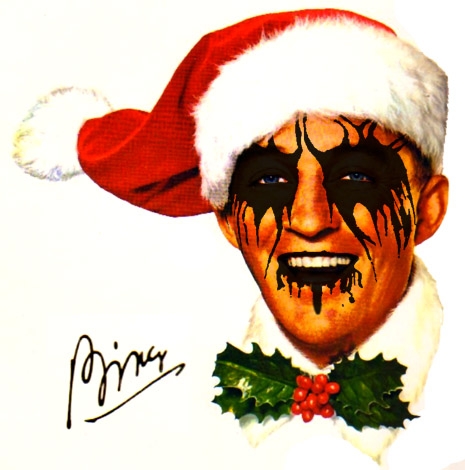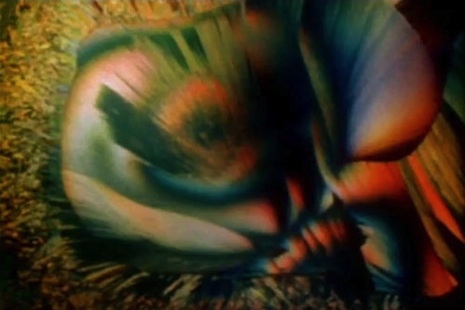
This is a guest post by Spencer Kansa, author of the Marjorie Cameron biography Wormwood Star, coming out soon in a new edition.
Bing Crosby and David Bowie bookend the 20th century of popular music. Massively influential and innovative in their own individual ways, these master vocalists were bona fide icons of their respective generations, with careers spanning 50 years. Still, few at the time would have believed that their collaboration in 1977, on Crosby’s Merrie Olde Christmas TV show, would become the beloved cultural artifact it is today.
On paper, it seemed an improbable pairing. The easygoing crooner, whose smooth reassuring voice helped shepherd Americans through the Depression and Second World War into peacetime prosperity, singing carols with the premier rock star of the Space Age, who’d risen to become the artistic driving force behind Western popular music. But any lingering doubts were banished that magical moment when Bowie’s cockneyfied croon gels perfectly with Bing’s bass-baritone and they start to sing.
For Crosby, the duet was a marvellous capper on an illustrious career in which he conquered the mediums of radio and television; become an Academy Award-winning actor and one of the biggest box office draws of the 1940s and 50s and, above all, reigned as one of the most successful recording artists in history, with a staggering 41 #1 hits, including “White Christmas,” which remains the world’s best-selling record of all time with over 50 million copies sold.
For Bowie, the duet was another surprising left turn that confirmed his status as the most audacious and uncategorizable pop artist of the 1970s; occurring at a midway point in his imperial period, that had seen him revolutionize how pop music was synthesised and presented on stage, on video, and on a dozen long-playing masterpieces. An astonishing creative streak that would further yield the new wave classics Lodger and Scary Monsters; the pop perfection of Let’s Dance and the global domination gained by its accompanying Serious Moonlight Tour, culminating with his commanding performance at Live Aid in 1985.
But the story behind the duet has generated certain myths over the years, and to iron out a few of them, I recently spoke with Bing’s daughter, the actress Mary Crosby, who, in 1980, rose to international prominence herself playing Kristin Shepard, the conniving, sloe-eyed seductress in the popular soap opera Dallas, and famously fired a couple of slugs into the dastardly J. R. Ewing, in a cliffhanger reveal watched by over 350 million viewers worldwide.
Since they began being broadcast in 1970, Bing Crosby’s Christmas specials had become a televisual tradition: a welcome, perennial presence in American homes. The 1977 episode happened to coincide with Bing’s 50th anniversary in showbiz, and as part of that celebration included concert performances in the UK that autumn, the programme-makers decided to film and set that year’s show in England, casting British entertainers. According to Mary, the idea to invite Bowie onto the show came from one of the producers, whose attitude was: ‘Wouldn’t it be wild?’ “They knew it was a long shot but it was a stroke of genius.” The offer came at an opportune for both singers who were, fortunately, able to synchronise their busy schedules. Bowie was already in England to drum up publicity for his latest single and album, Heroes, which was set to be released on September 23rd and October 14th respectively.
His TV itinerary began on September 7th, when he travelled to Granada Studios in Manchester to sing the title track on the teatime TV show fronted by his old mucker, Marc Bolan. He sang it to a backing track created by Bolan’s studio band, which included previous Bowie alums, Herbie Flowers (on bass) and Tony Newman (on drums), with Bowie himself trying his best to approximate Robert Fripps’s original guitar lines. Although they’d planned to end the show duetting a new song together (“Sitting Next To You”), this was scuppered when Bolan slipped off his monitor and the jobsworth crew refused to shoot another take.
Four days later, Bowie arrived at Elstree Studios in Borehamwood to perform “Heroes” again and “do something” with Bing Crosby.
For Mary Crosby, who performed on the show, alongside her actress mother, Kathryn, and her brothers, Harry and Nathaniel, Bowie’s arrival proved particularly memorable: “My brothers and I were teenagers at the time and Bowie walks in with this woman and they’re both wearing mink coats with full makeup on and red hair – and they matched! It was such an outrageous entrance.” Although she concedes that Bowie’s appearance – especially his Ziggy red hair – might not have been exactly as she remembers it, she’s adamant that he and his female companion – whom she assumed was his wife, although it was most likely Coco Schwab, Bowie’s personal assistant, as Bowie’s marriage to Angie was already in tatters – entered wearing full make-up. “Your memory changes with history, but their entrance was so outrageous. And they cleaned Bowie up for sure. They took off his full make-up. We were tickled; we were stunned. And we thought it was fantastic – and it was!”
One of the great anomalies of the show is the repeated story about how Bowie refused to sing the suggested “The Little Drummer Boy” song because he hated it and threatened to walk unless he was given an alternative number. This is the reason given for why the “Peace on Earth” counterpoint was hastily composed by the show’s writer, Buz Kohan, the composer, Larry Grossman, and the show’s music director, Ian Fraser. And yet, Bowie does actually perform “The Little Drummer Boy” tune; he and Crosby sing the first eight bars together before Bowie launches off into the counter-melody, and Mary Crosby believes this change of heart happened “once they got together. Any resistance there may have been was shifted when they realized they were in good hands with each other. When they went to the piano and started playing, David was nervous and dad was leery, but the moment the song started they both relaxed because it was all about the music.”
Bowie and Bing rehearsed this new arrangement, as well as their playful banter, which played upon their intergenerational differences, for an hour and then recorded the finished song in three takes. According to Kohan, Bing “loved the challenge,” and Mary relates how gracious and accommodating her father was when Bowie asked if they could change the original key to better suit his voice. For whatever reason the counterpoint was created, it proved to be an inspired course of action because it created a dynamic that wouldn’t have existed if they’d just settled on a straightforward singalong of the song. Mary agrees and remembers watching in amazement as the duet took shape: “My brothers and I didn’t know how it would pan out, and we watched as they worked through it on the soundstage, and it made me really happy when it happened. Even at the time, I knew magic was being made. I knew it was an extraordinary moment in time.”
The premise of the TV special sees the Crosby family travelling to England to spend Christmas at the home of their posh, long-lost relative, Sir Percival Crosby; and the show spoofs several characters from the then-popular British period drama, Upstairs, Downstairs, the Downton Abbey (without the budget) of its day. The Scottish comic actor, Stanley Baxter, drags up as Mrs. Bridges, the cook, and Rose the scullery maid, as well as portraying Hudson, the butler, from the original show.
Much more after the jump…









